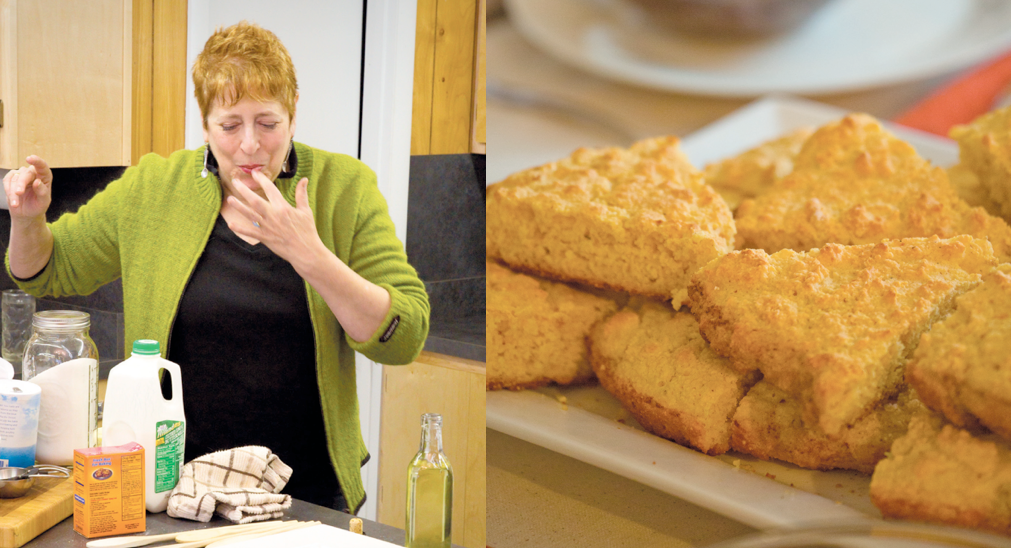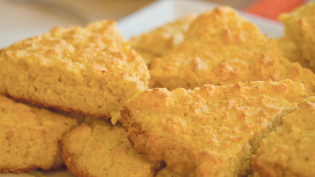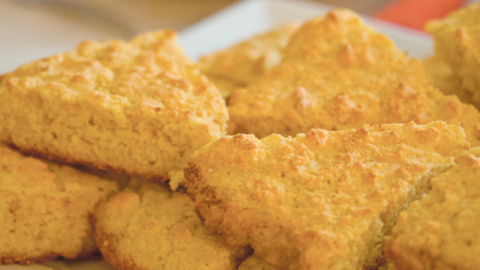Crescent's Cornbread
What does a self-made woman look like? In one case, she has short, red hair and vibrant, twinkly eyes.
At age 16, Crescent Dragonwagon chose her own name. At 17, she moved across the country and found the Ozarks. By 28, without formal culinary training, she and her husband, Ned Shank, opened Dairy Hollow House, a country inn and restaurant, in Eureka Springs. It was one of the first establishments in the region to highlight on the menu their use of locally sourced ingredients.
At 45, she co-founded the Writers’ Colony at Dairy Hollow, which Dragonwagon points out is the only one in the nation to have an entire suite devoted to culinary writing. Her cookbook, Passionate Vegetarian, which took 10 years to perfect and was written there at Dairy Hollow, won her, at age 51, the 2003 James Beard award for Vegetarian/Healthy Focus cookbook. Along the way, she has written five other cookbooks, 29 children’s books, two novels, and numerous poems, short stories, and magazine articles.
Success may seem to come easy to Dragonwagon, but she’s had her share of difficulty, as well.
Just after she turned 48, Shank was st ruck by a motorist while on his bicycle and lost his life. This loss was enough to push Dragonwagon, born a New Yorker, away from the Ozarkansas region she had called home for more than 30 years. She now lives in Westminster, Vermont, in the home where she spent her childhood summers.
In November, Dragonwagon was in Arkansas, where she returns every year for a visit with old friends and to offer workshops and events. This year, she was the keynote speaker for a Farm to Breakfast Community Meal during the Food Justice Summit in Fayetteville, hosted by Feed Communities and the University of Arkansas. She also held two events at Ozark Folkways in Winslow. The first of these events was an evening of poetry, prose, and song with her friend Crow Johnson, an award-winning songwriter and performer who co-founded the Writers’ Colony at Dairy Hollow with Dragonwagon in 1998. The second of the events was a spin on Dragonwagon’s traveling show, “Until Just Moistened: One Woman, Many Crumbs,” which is an intertwined celebration of life plus cornbread. Dragonwagon’s extroverted nature is clear to anyone who meets her, and she graciously told stories and occasionally sang, which she jests she “doesn’t do especially well,” throughout the evening. One thing that she does do well, however, is understand that food – all food – has a story behind it. Every recipe has a legacy. Dragonwagon reminds us that if this heritage is to endure, we must actively strive to preserve it. Writing cookbooks is her strategy to ensure this preservation of heritage. “It is important to be generous with received knowledge,” she says. “All of us are in the lineage – what was my aunt’s becomes mine, and then the reader’s.”
Dragonwagon’s relationship with cornbread began in Brooklyn, New York, in 1969. A friend of a neighbor, a soft-spoken woman from Georgia named Viola, taught Dragonwagon her recipe and her technique of baking cornbread in an preheated skillet. This is the recipe that Dragonwagon has used ever since, and that she demonstrated for the group in attendance at Ozark Folkways.
In the days of the restaurant at Dairy Hollow House, Dragonwagon served this very cornbread on each table, and she said the public didn’t know quite what to make of it, perhaps because it wasn’t a white dinner roll. Nevertheless, every night she would hear guests, as they peeled back the napkin and gazed into the breadbasket, cry out in delight, “Cornbread? I love cornbread!” On the busy nights, Dragonwagon would make batch after batch of this golden delight, pulling blazing hot, black skillets from the oven. No one would go without cornbread on her watch.
To point, in 2007, she devoted an entire cookbook to the golden delight, titling it The Cornbread Gospels. Her background and travels led her to realize what a diverse dish cornbread could be, and the time was right to share it with the public. She included more than 200 variations of recipes the book. There are similarities in the recipes, but many of the differences can be attributed to the region in which they were formed. Northern (which she affectionately calls Yankee) versus Southernstyle cornbread is the most known and significant difference, but Dragonwagon also distinguishes two more categories: African American and Embellished cornbreads.
Southern cornbread is thinner, more dense, and more textured – usually made from cornmeal. It is intentionally dry and intended to be eaten with soup or crumbled into a glass of buttermilk for an oldfashioned snack. As its most defining characteristic, Southern cornbread is free of sweetener, though there is on occasion “just a smidgen” to assist with browning. Summarized so well in The Accountant, the 2001 short film by Ray McKinnon, his character states that Southerners will know our way of life is gone when our “grandchildren will be eating cornbread that’s sweet, and drinking ice tea that ain’t, and they’ll think that’s the Southern tradition.”
Yankee cornbread has sugar and is often baked in a pan like a cake. It has flour as well as cornmeal, and is made with sweet milk, not the buttermilk Southern cooks prefer. This debate over which is better, sweetened or unsweetened cornbread, like tea, is long-standing. Added to the mix, Dragonwagon’s presentation brought to light another difference: whether or not a cook heats their skillet before adding the batter is also regional. Southern cornbread is poured into a hot skillet, and it bakes faster. Yankee cornbread takes longer to bake, both because it is poured into a cold skillet or pan, and because of the flour, which needs longer to rise.
African American cornbread is a blend of both North and South. According to Dragonwagon, it almost always has equal parts flour and cornmeal and is almost always sweet. Dragonwagon’s category of Embellished cornbreads is self-explanatory and includes the recipes of cooks adding anything from sweet corn kernels to hot chile peppers to their batter.
At the Ozark Folkways event, Dragonwagon demonstrated the Dairy Hollow House Skillet-Sizzled Cornbread recipe (shared on page 32). As she mixed the batter, she spoke of selecting fat as a f lavor carrier, depending on what you want the taste to be, and how it has evolved from bear fat, to pig fat, to, in her particular recipe, vegetable oil. The voice of experience went on to discourage the crowd from over-handling the batter, lest it have trouble rising properly.
“The essence of cornbread is the grit and the texture,” Dragonwagon said. “You want the ingredients barely combined. It’s lumpy. Until just moistened.” She also gave the hint on precisely when to add your mixture to the pan. “Warm your skillets,” she advises, “then add the butter. The butter pops and sizzles, and, as soon a sit goes quiet, that’s when you want to add your batter (or, in the case of a perfect omelette, the beaten egg). That gives you the delightful, crisp edge.”
That cornbread she demonstrated was baked until golden. Warm slices were served to the audience alongside a pot of Dragonwagon’s recipe for Elsie’s Cuban Black Bean Soup, prepared ahead of time by volunteers from Ozark Folkways.
The Southern cornbread has followed Dragonwagon to Vermont. “No one who eats my cornbread in Vermont goes back to eating Yankee cornbread,” she laughs. “We’ll have potlucks, and they’ll always say, ‘You’ve got to bring your cornbread – lots!’”
What’s next for Dragonwagon? She’s testing ideas including, but not limited to, a new novel, a memoir, and a four-part cookbook focusing on each season’s specialties. Whatever she does, it’s likely to be a scrumptious success, if her past is any indication. The Ozarkansas region will be proud to support her and welcome her home whenever she passes through, for the core of Dragonwagon seems to be golden and delightfully warm, just like good cornbread.
>> Dairy Hollow House Skillet-Sizzled Cornbread
You can keep up with Crescent Dragonwagon by opting-in to her newsletter at dragonwagon.com. There, you will also receive her short work, “Everything I need to know in life I learned from cornbread.”







